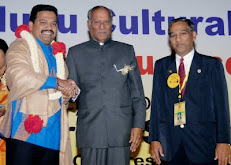Sri Varahalakshmi Narasimha Swamy Devalayam, Visakhapatnam
Simhachalam, the oldest temples in the world goes back to 11th
century. The word Simhachalam means the hill of the lion. It is the hill of the
great Nara-Simha, the forth incarnation of Lord Vishnu. Lord Vishnu descended
on Simhachalam Mountain to save Prahladaha devotee, who
was about to be dropped in the sea from the mountain top.
Simhachalam, the temple that is situated in Visakhapatnam,
Andhra Pradesh, India is one of the oldest temples
in the world. Simhachalam which rises to about 800feet above sea level is at a
distance of sixteen kilometers to the north of Visakhapatnam. It is approachable both from
Simhachalam Railway Station on the South Eastern Railway which is about four
kilometers from this place and also by means of motarable road from
Visakhapatnam Town where from public buses ply regularly.
Near the top of the north side of the hill, in a wooden hallow surrounded by a
wide circle of higher ground resembling an amphetheatre, is the temple of Narasimha which gives the hill its name.
This is the most famous, richest and the best sculptured shrine of the Northern Circars and the Rajahs of Vizianagaram, who have
endowed to it with lands etc., are its hereditary trustees for the last two
centuries. It has been brought under the purview of Hindu Religious and
Charitable Endowments Act under a special scheme.
The legend goes that Jaya and Vijaya the gate keepers of the celestial abode of
Lord Vishnu were cursed to be born as demons by the Lord for the disrespect
they showed to some visiting sages. They were born as Hiranyakasipu and
Kiranyasha to the sage Kasyapa and grew into mighty demon lords bent upon
disturbing the peace of the world. The younger of the two, Hiranyaksha, seized
the earth and carried it to another region. Lord Vishnu delivered the earth
from the clutches of the demon by assuming the Boar incarnation (Varaha
Avatara) aggrieved by the death of his brother, Hiranyakaspipu wanted to avenge
the death of his brother. He added to his might the power of penance and began
to punish the gods and sages, the devotees of Lord Vishnu. Lord Vishnu was once
again prevailed upon to rescue the world from the menace of this demon. Then
the Lord made one of his servants, Sumukha, to be born as a son of
Hiranyakasipu. This son of Hiranyakasipu, named Prahlada, became a devotee of
Vishnu even his birth and thus brought upon himself the wrath of his father.
Hiranyakasipu tried tomend the ways of his erring son, but when he found him to
be adamant, made him undergo several hardships. He made the elephants trample
over him and set poisonous snakes against him. Prahlada protected as he was
diving grace, stood firm. Hiranyakasipu, as a lost resort, asked his events to
throw his son into the sea and place a mountain over him.
His servants chose to drop Prahlada in the sea near the mount Simhadri
with a view to place the mountain over him. But before they could complete
their act Lord Narauyana rescued him by jumping over the hill and lifting up
Prahalada from the sea. Simhadri is thus the place where the Lord rescued
Prahlada. The form of Varaaha Narasimha was assumed by him, then at the prayer
of his devotee Prahlada, who wanted to see both the aspects of the Lord, the
one by which he had already killed Hiranyakasha and the other by which he
killed Hiranyakasipu.
According to the Sthalapurana, Prahlada was the first person to construct a
temple round the Deity. He accomplished this after his father's death at the
hands of Narasimha. But at the end of that life-cycle (Krita Yuga), the temple
was neglected and began to decay. Even the Deity was not taken care of and
crests of earth slowly gathered round the image. But, at the beginning of
another life cycle, the Lord once again was discovered by pururava of the Lunar
Dynasty.
Pururava, with his spouse Urvasi, riding on an aerial chariot over the hill of
the South was drown to the Simhachalam by a mysterious power. He discovered the
Lord on hill lying imbedded in crests of earth. He cleared the earth among the
image of the Lord. The he was addressed by the Akasavani not to expose the
image but cover it with sandal paste. It also added that the Lord should be
worshipped in this form, and only once in a year, on the third day in the month
of Vysakaha his Nijaswarupa can be revealed. Acting under the instructions of
Akasavani the kind applied over the image of an amount of sandal wood paste
which is equal to the earth he had removed worshipped the deity and built the
temple once again around the image. The temple continued to flourish
eversince.Thus Sri Varaha Lakshmi Narasimha Swamy is the presiding Deity of
Mountain Kilas of Simhachalam
The temple is visited by pilgrims in large number particularly during Saturdays
and Sundays and from April to June and the pilgrimage during other seasons is
not less. The important festivals are the annual Kalyanam, which takes on
Chaitra Suddha Ekadasi i.e., in the month of March/April and Chandana Yatra on
the third day of Vysakhamasam i.e., in the month of April/May.
- See more at:
http://www.astrologyforu.com/temples/visakhapatnam-simhachalam.php#sthash.tD4Qjpoz.dpuf






.jpg)
.jpg)
.jpg)
.jpg)
.jpg)

